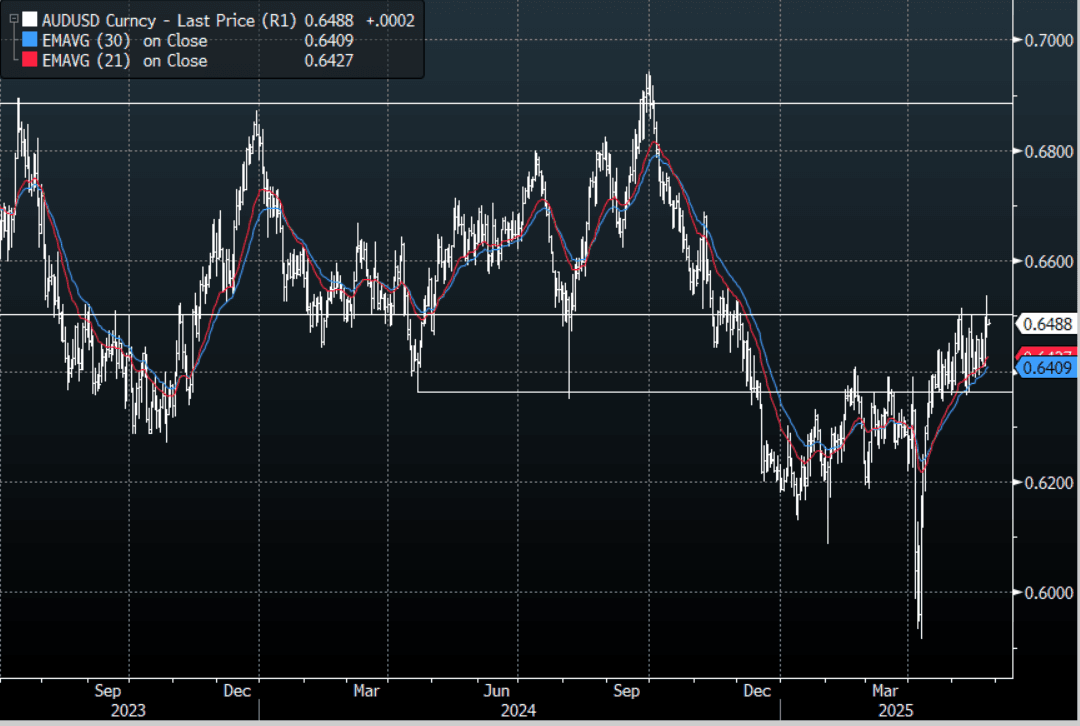AUD: AUD/USD - Fails To Hold Gains Above 0.6500
The AUD had a range overnight of 0.6482 - 0.6531, Asia is opening around 0.6490. The USD spent most of the overnight session clawing back its losses from the Asian open. The AUD opens around the same level it did Monday morning.
- Bloomberg - “Investors from Australia, Canada, the UK and other countries that impose “digital services taxes” on large technology companies like Meta would face higher tax rates on income earned in the US if a bill making its way to the Senate becomes law.”
- “The EU said it agreed to accelerate negotiations with the US to avoid a transatlantic trade war, signaling a more amicable approach just days after President Trump criticized the bloc for taking advantage of the US and slow-walking talks.’(BBG)
- The AUD/USD could not hold its gains above 0.6500, it remains in a 0.6350 - 0.6550 range but is likely to test the top end again over the course of this week.
- The AUD continues to hold up pretty well against the USD so If you want to express a short it looks best to do that in the crosses for now.
- Expect buyers to continue to be around on dips while the support in the AUD holds, a close back below 0.6300/50 would start to challenge the newly formed uptrend. A break above 0.6550 and the move higher could begin to accelerate.
- Options : Closest significant option expiries for NY cut, based on DTCC data: 0.6510(AUD1.55b), 0.6550(AUD 610m), 0.6500(AUD 443m). Upcoming Close Strikes : none
- CFTC Data shows Asset managers have continued to add to their shorts, the Leveraged community also added to shorts though still a very small position.
Data/Event: AU CPI Wednesday
Fig 1: AUD/USD spot Daily Chart

Source: MNI - Market News/Bloomberg
Want to read more?
Find more articles and bullets on these widgets:
Historical bullets
US TSYS: Extraordinary Measures And Cash Look Sufficient To Head Off X-Date
Treasury has about $164B in "extraordinary measures" available as of April 23 to avoid hitting the debt limit, per its regular report out Friday. That's out of a maximum total of $375B (they have used $211B).
- With Treasury cash looking healthy (around $600B), that's a fair amount of dry powder to get through the summer months to wait out the debt limit impasse. Tax receipts have looked strong with tariff revenues also starting to boost cash flows, further reducing the near-term urgency to adjust bond issuance.
- This has also helped push back analyst “x-date” expectations to later in the summer/September. We expect to hear from Treasury about its own x-date assumptions next week.

US TSYS: Treasury Market Trading Stayed Orderly In April: Fed Report
Liquidity across financial markets including the Treasury market deteriorated after President Trump's April 2 reciprocal tariffs announcement but market functioning was generally orderly, according to the Federal Reserve's semiannual report on financial stability, released Friday. (PDF link is here)
- Treasury market liquidity has been poor for years and yields were particularly volatile in early April, contributing to a deterioration in market liquidity, the Fed said.
- Nevertheless "trading remained orderly, and markets continued to function without serious disruption," according to the report, which looked at information available as of April 11.
FED: Ex-Gov Warsh: Fed Has Failed To Satisfy Price Stability Remit
From our Washington Policy Team - Some fairly sharp words today from ex-Fed Governor Warsh on the central bank (who for what it's worth is seen by betting markets as by far the frontrunner for the next Fed Chair):
- The best way for the Federal Reserve to safeguard its independence is for policymakers to avoid expanding the institution's role over time, including wading into policy areas that are outside its core mission, former Fed Governor Kevin Warsh, a leading contender to replace Jerome Powell as chair next year, said Friday.
- "I strongly believe in the operational independence of monetary policy as a wise political economy decision. And I believe that Fed independence is chiefly up to the Fed," Warsh said in a speech at a Group of Thirty event on the sidelines of the IMF meetings. "Institutional drift has coincided with the Fed’s failure to satisfy an essential part of its statutory remit, price stability. It has also contributed to an explosion of federal spending." His speech made no mention of Trump's tariffs or the appropriate monetary policy to deal with them.
- He said the ideas of data dependence and forward guidance widely adopted by Fed officials are not especially useful and might even be counterproductive.
"We should care little about two numbers to the right of the decimal point in the latest government release. Breathlessly awaiting trailing data from stale national accounts -- subject to significant, subsequent revision -- is evidence of false precision and analytic complacency," he said.
"Near-term forecasting is another distracting Fed preoccupation. Economists are not immune to the frailties of human nature. Once policymakers reveal their economic forecast, they can become prisoners of their own words. Fed leaders would be well-served to skip opportunities to share their latest musings."